Application of Carbon-Fiber-Reinforced Polymer Rods and Ultra-High-Performance Fiber-Reinforced Concrete Jackets with Mechanical Anchorage Systems to Reinforced Concrete Slabs
Abstract
Highlights
- A new approach for strengthening RC slabs was developed, employing an exterior UHPFRC jacket with a mechanical anchorage system (MAS).
- The suggested retrofitting system improved resistance to initial cracks of the slabs.
- The addition of mechanical anchorage system enhanced the bond between UHPFRC and NSC.
- The proposed strengthening technique effectively prevented early debonding.
- The finite element (FE) and analytical model outcomes exhibited a high degree of alignment with the experimental findings.
Abstract
1. Introduction
2. Developing a New Strengthening Technique for Slabs
3. Experimental Program
3.1. Slab Specimen Design
3.2. Properties of Materials
3.3. Slabs Casting
| Item | Characteristics | |
|---|---|---|
| NSC | Mean compression strength (MPa) | 34.8 |
| UHPFRC | Mean compression strength (MPa) | 144.2 |
| Reinforcing steel | Yield strength (MPa) | 600 |
| Elasticity modulus (GPa) | 210 | |
| Poisson’s ratio | 0.25 | |
| Density (kg/m3) | 7850 | |
| CFRP [34] | Fiber content (%) | >68% |
| Tensile strength (MPa) | 2500 | |
| Elasticity modulus (GPa) | 153 | |
| Poison’s ratio | 0.2 | |
| Expansion bolt [35] | Tensile strength (MPa) | 700 |
| Yield strength (MPa) | 560 | |
| Elasticity modulus (GPa) | 206 | |
| Poison’s ratio | 0.28 | |
| Steel plate | Yield strength (MPa) | 425 |
| Elasticity modulus (GPa) | 207 | |
| Poisson’s ratio | 0.29 | |
| Density (kg/m3) | 7860 | |
| Adhesive mortar [37] | Compressive strength (MPa) | 63 |
| Tensile strength (MPa) | 39 | |
| Elasticity modulus (GPa) | 4.48 | |
| Poisson’s Ratio | 0.37 |
3.4. Experimental Testing
4. Finite Element Modeling Program
4.1. Concrete Constitutive Model
4.2. Steel, CFRP, and Epoxy Adhesive Mortar Models
4.3. Element Type, Interface, Boundary Condition, and Mesh
5. Discussion of Results
5.1. Experimental Slabs
5.2. Verification of FE Models Using Experimental Results
5.3. Results of the Comparison of Various Strengthening Methods
6. Analytical Model of Slabs
Validation of Results for the Analytical Models
7. Conclusions
- The suggested retrofitting system substantially improved resistance to initial cracks and delayed the development of flexural cracks in the slabs.
- The retrofitted reinforced concrete slabs exhibited an 82% higher initial cracking load compared to the reference slab.
- The maximum load capacity of the retrofitted RC slabs increased by 61% and 82%, respectively, and the stiffness also improved by 7% and 46%.
- The proposed strengthening technique effectively prevented early debonding, as no debonding occurred between the NSC and UHPFRC layers throughout all the phases of testing.
- The mechanical anchor systems stayed firmly intact within the slabs up to the failure phase, indicating the effectiveness and reliability of the proposed retrofitting approach.
- The finite element (FE) outcomes for both the unstrengthened and strengthened slabs exhibited a high degree of alignment with the experimental findings.
- The newly proposed strengthening method proved to be more efficient and effective in improving slab performance compared to traditional techniques.
- The stiffness of the strengthened slabs that were modified using traditional methods (near-surface-mounted (NSM) CFRP rebar approach, externally attached CFRP strips approach, and the use of an epoxy adhesive method to bond the UHPFRC jacket) decreased by 16%, 17%, and 8%, respectively, compared to the SB3 experimental slab.
- The analytical model approach yielded good estimates for forecasting the maximum moment capacity of RC -members reinforced by employing different techniques.
- It is recommended to carry out further studies on the application of the newly proposed technique to other reinforced concrete members, such as columns or beams, because it significantly enhanced the strength of the RC slabs and prevented premature debonding.
Author Contributions
Funding
Institutional Review Board Statement
Informed Consent Statement
Data Availability Statement
Conflicts of Interest
References
- Prem, P.R.; Murthy, A.R. Acoustic emission and flexural behaviour of RC beams strengthened with UHPC overlay. Constr. Build. Mater. 2016, 123, 481–492. [Google Scholar] [CrossRef]
- Hassan, F.; Hejazi, F.; Saifulnaz, R.; Rashid, M. Strengthening of reinforced concrete slabs using carbon fiber reinforced polymers rods and concrete jacket with a mechanical anchorage system. Constr. Build. Mater. 2024, 440, 137464. [Google Scholar] [CrossRef]
- Brühwiler, E. Rehabilitation of concrete bridges using Ultra-High Performance Fibre Reinforced Concrete (UHPFRC). In Proceedings of the 3rd International Symposium on Life-Cycle Civil Engineering, Vienna, Austria, 3–6 October 2012; Volume 1, pp. 1934–1941. Available online: https://infoscience.epfl.ch/handle/20.500.14299/86194 (accessed on 12 February 2022).
- Le Hoang, A.; Fehling, E. Influence of steel fiber content and aspect ratio on the uniaxial tensile and compressive behavior of ultra high performance concrete. Constr. Build. Mater. 2017, 153, 790–806. [Google Scholar] [CrossRef]
- Tayeh, B.A.; Bakar, B.H.A.; Johari, M.A.M.; Voo, Y.L. Mechanical and permeability properties of the interface between normal concrete substrate and ultra high performance fiber concrete overlay. Constr. Build. Mater. 2012, 36, 538–548. [Google Scholar] [CrossRef]
- Brühwiler, E.; Denarié, E. Rehabilitation and Strengthening of Concrete Structures Using Ultra-High Performance Fibre Reinforced Concrete. Struct. Eng. Int. 2013, 23, 450–457. [Google Scholar] [CrossRef]
- Wu, Z.; Shi, C.; Khayat, K.H. Investigation of mechanical properties and shrinkage of ultra-high performance concrete: Influence of steel fiber content and shape. Compos. Part B Eng. 2019, 174, 107021. [Google Scholar] [CrossRef]
- Noshiravani, T.; Brühwiler, E. Rotation capacity and stress redistribution ability of R-UHPFRC-RC composite continuous beams: An experimental investigation. Mater. Struct. Constr. 2013, 46, 2013–2028. [Google Scholar] [CrossRef]
- Habel, K.; Gauvreau, P. Response of ultra-high performance fiber reinforced concrete (UHPFRC) to impact and static loading. Cem. Concr. Compos. 2008, 30, 938–946. [Google Scholar] [CrossRef]
- Chun, B.; Yoo, D.Y. Hybrid effect of macro and micro steel fibers on the pullout and tensile behaviors of ultra-high-performance concrete. Compos. Part B Eng. 2019, 162, 344–360. [Google Scholar] [CrossRef]
- Liu, J.; Han, F.; Cui, G.; Zhang, Q.; Lv, J.; Zhang, L.; Yang, Z. Combined effect of coarse aggregate and fiber on tensile behavior of ultra-high performance concrete. Constr. Build. Mater. 2016, 121, 310–318. [Google Scholar] [CrossRef]
- Banerji, S.; Kodur, V.; Solhmirzaei, R. Experimental behavior of ultra high performance fiber reinforced concrete beams under fire conditions. Eng. Struct. 2020, 208, 110316. [Google Scholar] [CrossRef]
- Murthy, A.R.; Karihaloo, B.L.; Rani, P.V.; Priya, D.S. Fatigue behaviour of damaged RC beams strengthened with ultra high performance fibre reinforced concrete. Int. J. Fatigue 2018, 116, 659–668. [Google Scholar] [CrossRef]
- El-Mandouh, M.A.; Elsamak, G.; Rageh, B.O.; Hamoda, A.; Abdelazeem, F. Experimental and numerical investigation of one-way reinforced concrete slabs using various strengthening systems. Case Stud. Constr. Mater. 2023, 18, e01691. [Google Scholar] [CrossRef]
- Nadir, W.; Kadhimi, M.M.A.; Jawdhari, A.; Fam, A.; Majdi, A. RC beams strengthened in shear with FRP-Reinforced UHPC overlay: An experimental and numerical study. Structures 2023, 53, 693–715. [Google Scholar] [CrossRef]
- Wang, H.; Zhou, Z.; Zhang, Z.; Zou, Y.; Jiang, J.; Zeng, X. Experimental and numerical studies on shear behavior of prefabricated bridge deck slabs with compact UHPC wet joint. Case Stud. Constr. Mater. 2023, 19, e02362. [Google Scholar] [CrossRef]
- Su, Y.L.; Wu, C.; Shang, J.Q.; Zhang, P.; Sheikh, S.A. Experimental and numerical simulation research on the flexural performance of beams reinforced with GFRP bars and three-sides UHPC layer. Structures 2024, 59, 105746. [Google Scholar] [CrossRef]
- Shan, Y.; Gong, Y.; Wang, Y.; Zhou, Q.; Li, X.; Ding, F.; Kuang, Y. Flexural behavior of ultra-high performance concrete (UHPC) shaped thin-plate ribbed staircases: An experimental and numerical study. Mater. Struct. Constr. 2024, 57, 18. [Google Scholar] [CrossRef]
- Safdar, M.; Matsumoto, T.; Kakuma, K. Flexural behavior of reinforced concrete beams repaired with ultra-high performance fiber reinforced concrete (UHPFRC). Compos. Struct. 2016, 157, 448–460. [Google Scholar] [CrossRef]
- Paschalis, S.A.; Lampropoulos, A.P.; Tsioulou, O. Experimental and numerical study of the performance of ultra high performance fiber reinforced concrete for the flexural strengthening of full scale reinforced concrete members. Constr. Build. Mater. 2018, 186, 351–366. [Google Scholar] [CrossRef]
- Murthy, A.R.; Karihaloo, B.L.; Priya, D.S. Flexural behavior of RC beams retrofitted with ultra-high strength concrete. Constr. Build. Mater. 2018, 175, 815–824. [Google Scholar] [CrossRef]
- Ahmed, S.; Mohamed, E.Y.; Mohamed, H.A.; Emara, M. Experimental and numerical investigation of flexural behavior of RC beams retrofitted with reinforced UHPFRC layer in tension surface. Structures 2023, 49, 106–123. [Google Scholar] [CrossRef]
- Yang, J.; Yu, J.; Zhang, Z.; Zou, Y.; Chen, R.; Zhou, J.; Li, B. Flexural behavior of 15-year-old full-scale hollow slab beams strengthened with fiber-reinforced composites. Case Stud. Constr. Mater. 2023, 19, e02545. [Google Scholar] [CrossRef]
- Zhang, Y.; Wang, H.; Qin, Y.; Huang, S.; Fan, W. Experimental and analytical studies on the flexural behavior of steel plate-UHPC composite strengthened RC beams. Eng. Struct. 2023, 283, 115834. [Google Scholar] [CrossRef]
- Yoo, D.Y.; Banthia, N.; Kim, S.W.; Yoon, Y.S. Response of ultra-high-performance fiber-reinforced concrete beams with continuous steel reinforcement subjected to low-velocity impact loading. Compos. Struct. 2015, 126, 233–245. [Google Scholar] [CrossRef]
- Lampropoulos, A.P.; Paschalis, S.A.; Tsioulou, O.T.; Dritsos, S.E. Strengthening of reinforced concrete beams using ultra high performance fibre reinforced concrete (UHPFRC). Eng. Struct. 2016, 106, 370–384. [Google Scholar] [CrossRef]
- Hong, S.G.; Lim, W.Y. Strengthening of shear-dominant reinforced concrete beams with ultra-high-performance concrete jacketing. Constr. Build. Mater. 2023, 365, 130043. [Google Scholar] [CrossRef]
- Yin, H.; Teo, W.; Shirai, K. Experimental investigation on the behaviour of reinforced concrete slabs strengthened with ultra-high performance concrete. Constr. Build. Mater. 2017, 155, 463–474. [Google Scholar] [CrossRef]
- Paschalis, S.A.; Lampropoulos, A.P. Developments in the use of Ultra High Performance Fiber Reinforced Concrete as strengthening material. Eng. Struct. 2021, 233, 111914. [Google Scholar] [CrossRef]
- Said, A.; Elsayed, M.; El-Azim, A.A.; Althoey, F.; Tayeh, B.A. Using ultra-high performance fiber reinforced concrete in improvement shear strength of reinforced concrete beams. Case Stud. Constr. Mater. 2022, 16, e01009. [Google Scholar] [CrossRef]
- Qsymah, A.; Ayasrah, M. Finite Element Analysis of Two-Way Reinforced Concrete Slabs Strengthened with FRP Under Flexural Loading. Buildings 2024, 14, 3389. [Google Scholar] [CrossRef]
- Pedram, Z.; Xiong, Y.; Xin, J.; Amir, M. Punching Shear Enhancement of Flat Slabs with Partial Use of Ultrahigh-Performance Concrete. J. Mater. Civ. Eng. 2015, 27, 4014255. [Google Scholar] [CrossRef]
- ASTM Standard A29/A29M −12; Standard Specification for General Requirements for Steel Bars, Carbon and Alloy, Hot-Wrought. ASTM International: West Conshohocken, PA, USA, 2013; Volume 1, pp. 1–16.
- PRODUCT DATA SHEET. Sika ® CarboDur ® BC 8. BUILDING TRUST. 2023. Available online: https://gbr.sika.com/dam/dms/gb01/j/sika-carbodur-bc8.pdf (accessed on 11 March 2023).
- Datasheet, T. Hilti HST3 Expansion Anchor. Hilti. Available online: https://www.hilti.com (accessed on 11 March 2023).
- Pan, B.; Liu, F.; Zhuge, Y.; Zeng, J.J.; Liao, J.J. ECCs/UHPFRCCs with and without FRP reinforcement for structural strengthening/repairing: A state-of-the-art review. Constr. Build. Mater. 2022, 316, 125824. [Google Scholar] [CrossRef]
- PRODUCT DATA SHEET. Sikadur®-732. BUILDING TRUST. 2020. Available online: https://sgp.sika.com/dam/dms/sg01/d/sikadur_-732.pdf (accessed on 11 March 2023).
- Abaqus theory manual. Abaqus 6.13 Documents; no. Dassault Systemes Simulia Corp.: Providence, RI, USA, 2014. [Google Scholar]
- Khalaf, M.R.; Al-Ahmed, A.H.A.; Allawi, A.A.; El-Zohairy, A. Strengthening of continuous reinforced concrete deep beams with large openings using cfrp strips. Materials 2021, 14, 3119. [Google Scholar] [CrossRef]
- Al-Rousan, R.Z. Integration of CFRP strips as an internal shear reinforcement in reinforced concrete beams exposed to elevated temperature. Case Stud. Constr. Mater. 2021, 14, e00508. [Google Scholar] [CrossRef]
- Su, M.; Gong, S.; Liu, Y.; Peng, H. Flexural behavior of RC beams strengthened with fully or partially prestressed near-surface mounted FRP strips: An experimental investigation. Eng. Struct. 2022, 262, 114345. [Google Scholar] [CrossRef]
- Hosen, M.A.; Jumaat, M.Z.; Alengaram, U.J.; Sulong, N.H.R. CFRP strips for enhancing flexural performance of RC beams by SNSM strengthening technique. Constr. Build. Mater. 2018, 165, 28–44. [Google Scholar] [CrossRef]
- Aules, W.; Saeed, Y.M.; Rad, F.N. A novel anchorage system for strengthening slender RC columns with externally bonded CFRP composite sheets. Constr. Build. Mater. 2020, 245, 118423. [Google Scholar] [CrossRef]
- Barris, C.; Sala, P.; Gómez, J.; Torres, L. Flexural behaviour of FRP reinforced concrete beams strengthened with NSM CFRP strips. Compos. Struct. 2020, 241, 112059. [Google Scholar] [CrossRef]
- Karayannis, C.; Golias, E. An Innovative Technique for the Strengthening of RC Columns and Their Connections with Beams Using C-FRP ROPES. Appl. Sci. 2024, 14, 8395. [Google Scholar] [CrossRef]
- Saeed, Y.M.; Aules, W.A.; Rad, F.N.; Raad, A.M. Tensile behavior of FRP anchors made from CFRP ropes epoxy-bonded to uncracked concrete for flexural strengthening of RC columns. Case Stud. Constr. Mater. 2020, 13, e00435. [Google Scholar] [CrossRef]
- 440.2R-17; Guide for the Design and Construction of Externally Bonded FRP Systems for Strengthening Concrete Structures. ACI: Farmington Hills, MI, USA, 2017.
- ACI 318-19; Building Code Requirements for Structural Concrete (Reapproved 2022). ACI: Farmington Hills, MI, USA, 2019.
- GB 50010; National Standard of the People’s Republic of China—Code for Design of Concrete Structures. Construction: Beijing, China, 2002; pp. 64–73.
- Jia, L.; Fang, Z.; Huang, Z.; Pilakoutas, K.; Wang, Q.; Tan, X. Flexural behavior of uhpc beams prestressed with external cfrp tendons. Appl. Sci. 2021, 11, 9189. [Google Scholar] [CrossRef]
- Birtel, V.; Mark, P. Parameterised Finite Element Modelling of RC Beam Shear Failure. In Proceedings of the ABAQUS Users’ Conference, Cambridge, MA, USA, 23–25 May 2006; pp. 95–108. [Google Scholar]
- Obaidat, Y.T.; Heyden, S.; Dahlblom, O. The effect of CFRP and CFRP/concrete interface models when modelling retrofitted RC beams with FEM. Compos. Struct. 2010, 92, 1391–1398. [Google Scholar] [CrossRef]
- Zidani, M.B.; Belakhdar, K.; Tounsi, A.; Bedia, E.A.A. Finite element analysis of initially damaged beams repaired with FRP plates. Compos. Struct. 2015, 134, 429–439. [Google Scholar] [CrossRef]
- Walsh, H.H.H.K.; Sargand, S.M.; Al Rikabi, F.T.; Steinberg, E.P. Modeling the Shear Connection in Adjacent Box-Beam Bridges with Ultrahigh-Performance Concrete Joints. I: Model Calibration and Validation. J. Bridg. Eng. 2017, 22, 4017043. [Google Scholar] [CrossRef]
- Smith, S.T.; Hu, S.; Kim, S.J.; Seracino, R. FRP-strengthened RC slabs anchored with FRP anchors. Eng. Struct. 2011, 33, 1075–1087. [Google Scholar] [CrossRef]
- Elsanadedy, H.M.; Abbas, H.; Almusallam, T.H.; Al-Salloum, Y.A. Hybrid UHPC/NSM CFRP strips vs. traditional systems for flexural upgrading of RC beams—Experimental and FE study. Compos. Struct. 2021, 261, 113291. [Google Scholar] [CrossRef]
- Santos, L.R.D.; de Sousa Cardoso, H.; Caldas, R.B.; Grilo, L.F. Finite element model for bolted shear connectors in concrete-filled steel tubular columns. Eng. Struct. 2020, 203, 109863. [Google Scholar] [CrossRef]
- Hawileh, R.A.; Rasheed, H.A.; Abdalla, J.A.; Al-Tamimi, A.K. Behavior of reinforced concrete beams strengthened with externally bonded hybrid fiber reinforced polymer systems. Mater. Des. 2014, 53, 972–982. [Google Scholar] [CrossRef]
- ACI 318-11; Building Code Requirements for Structural Concrete. ACI: Farmington Hills, MI, USA, 2011.

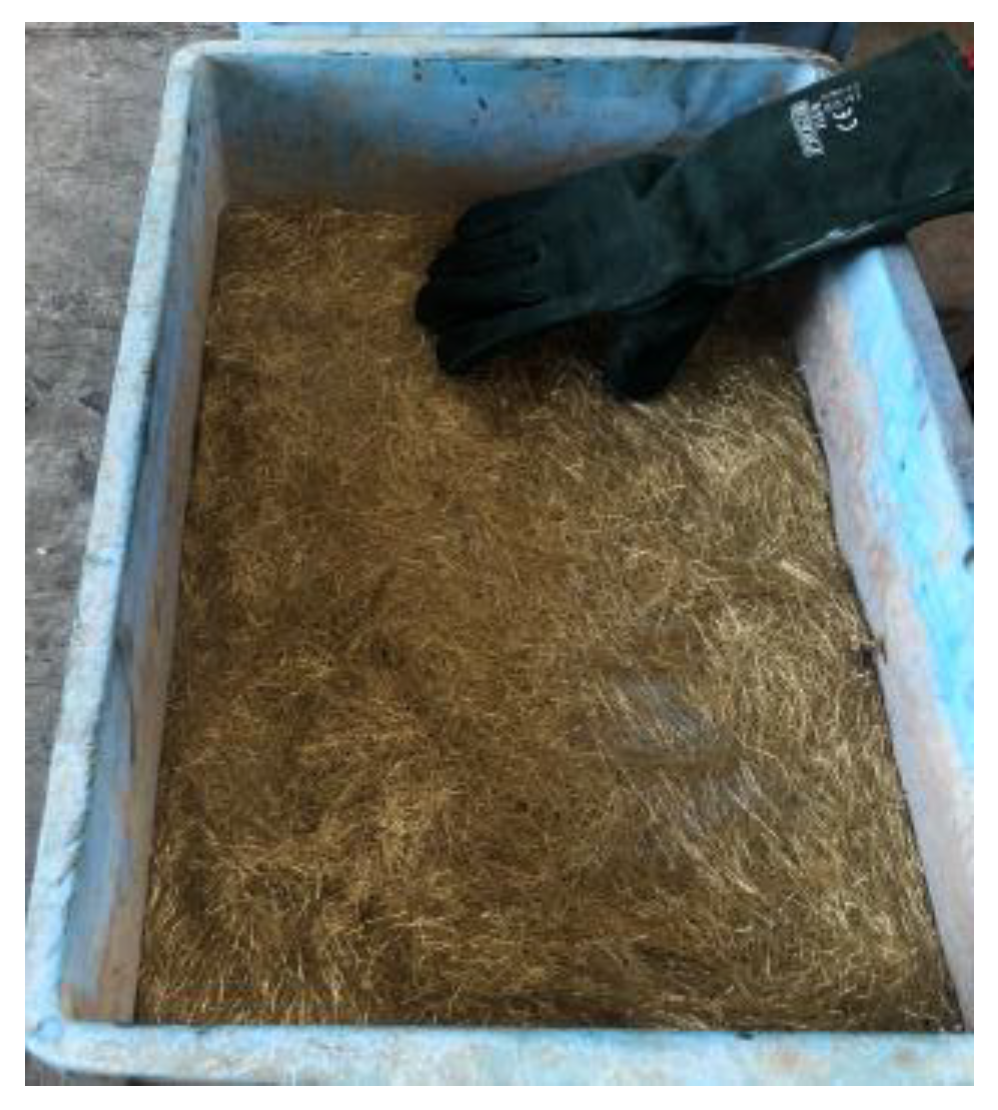
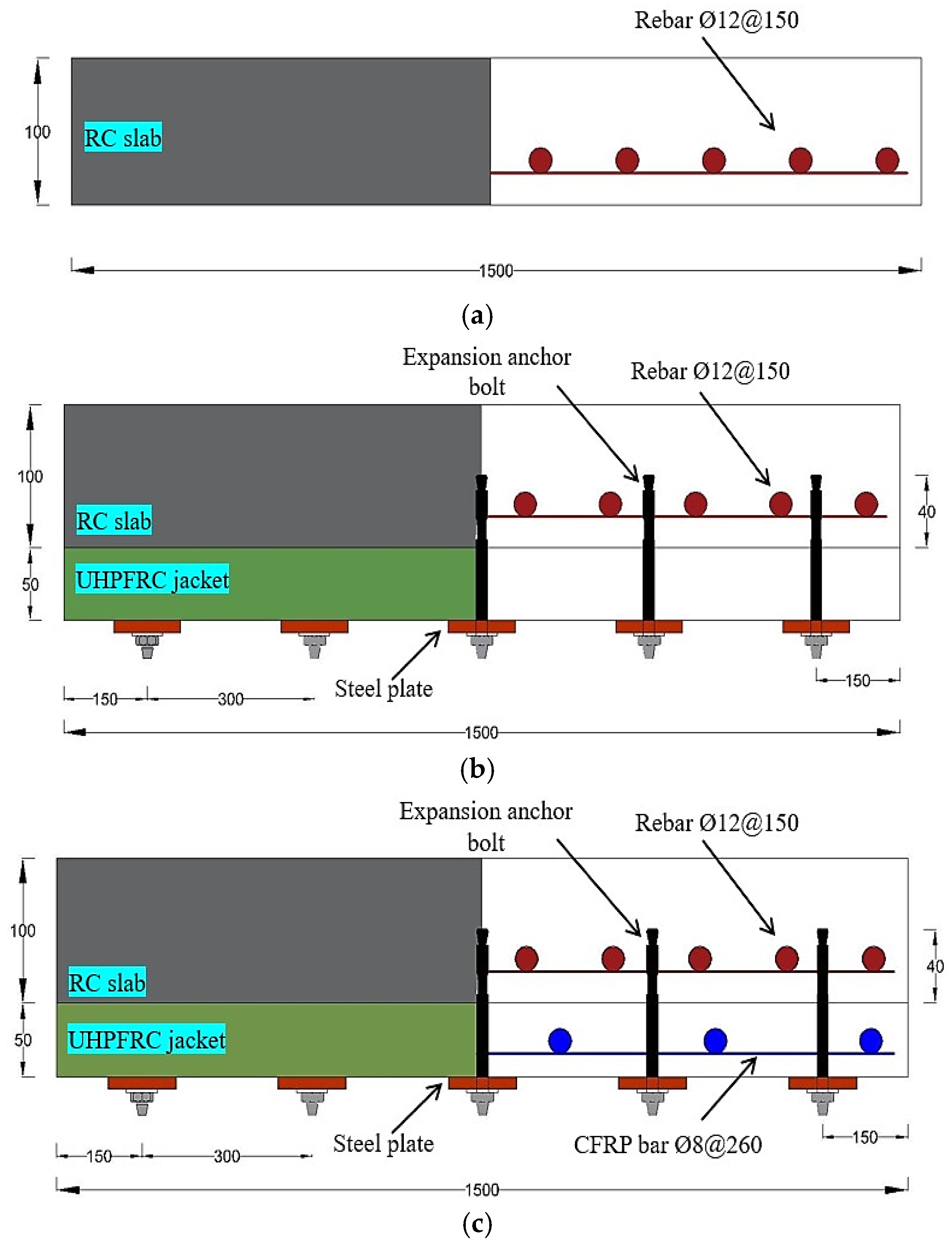
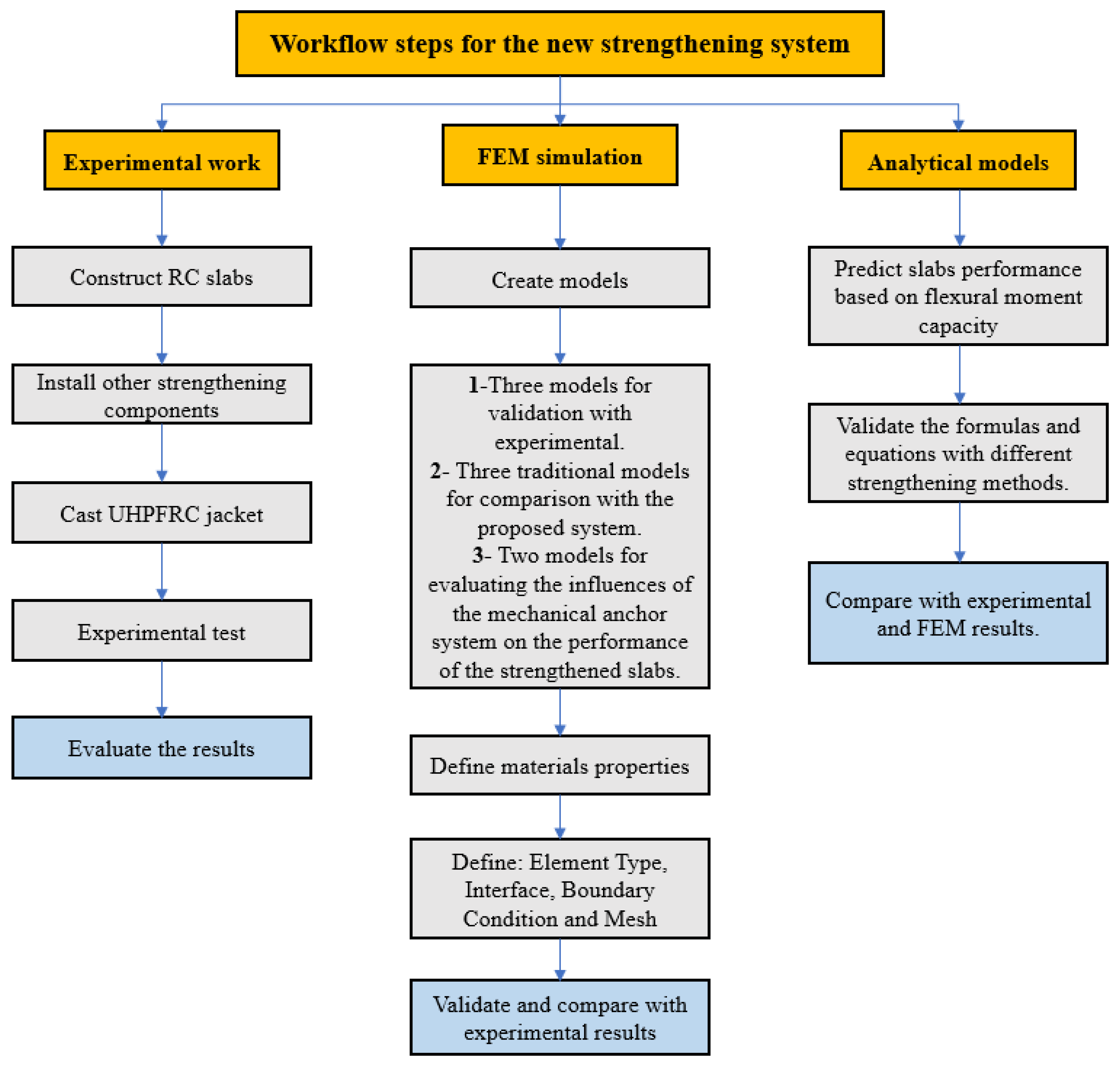
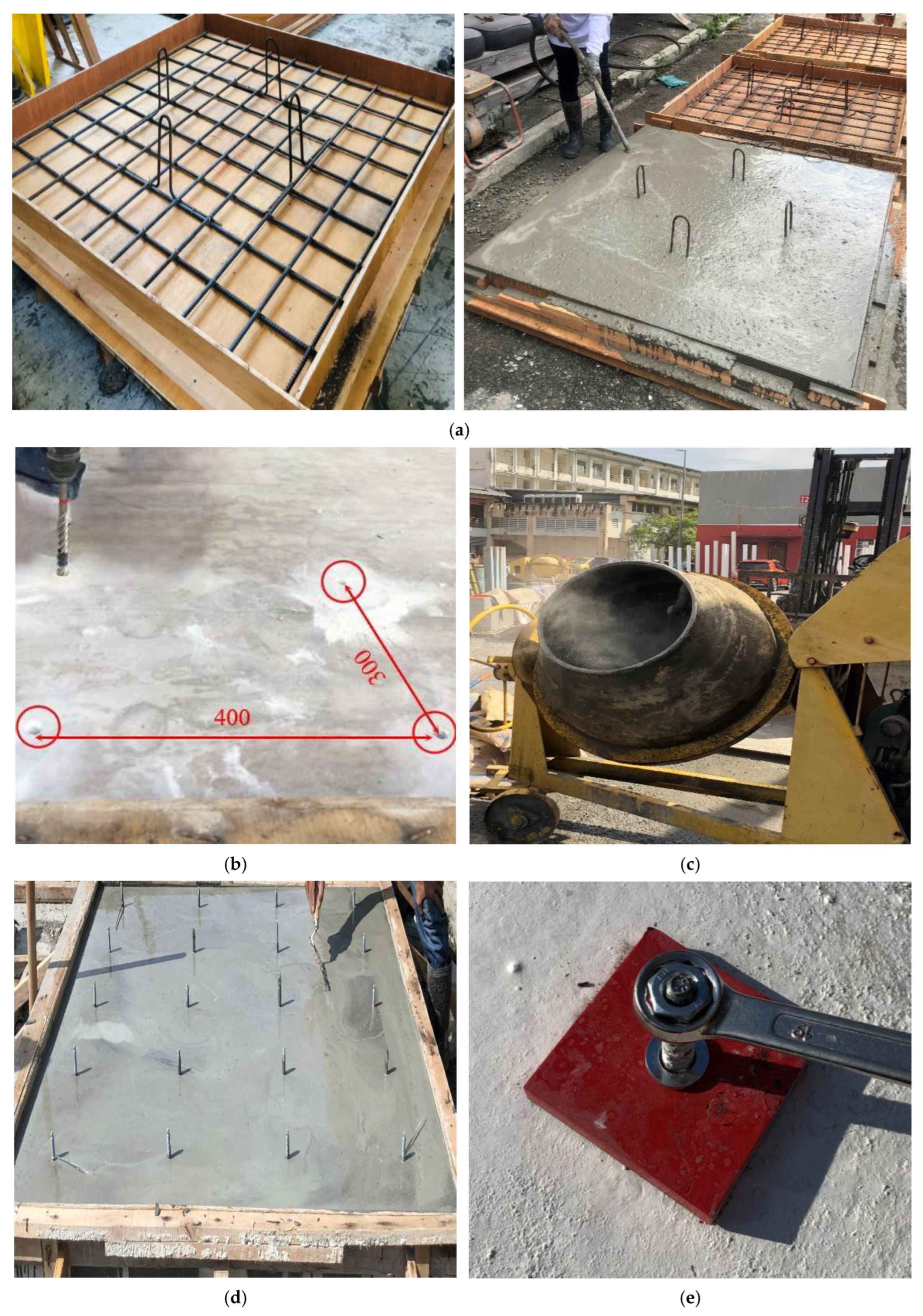
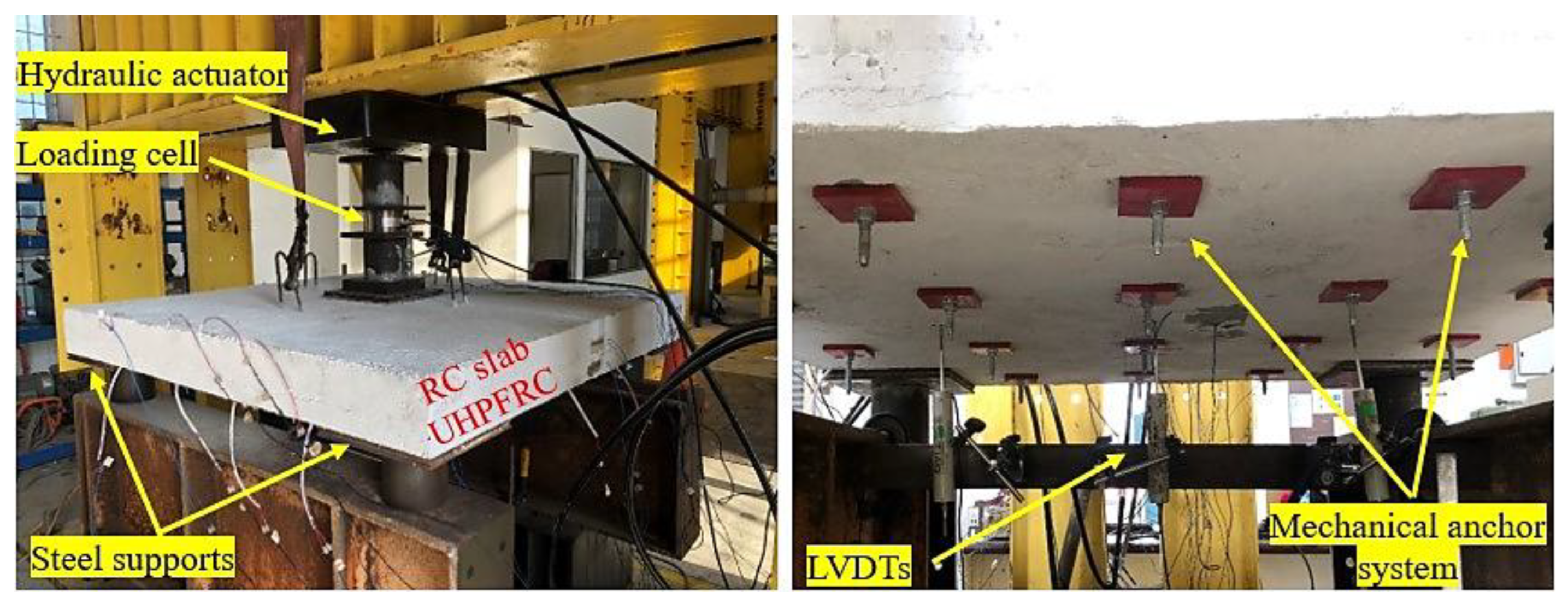

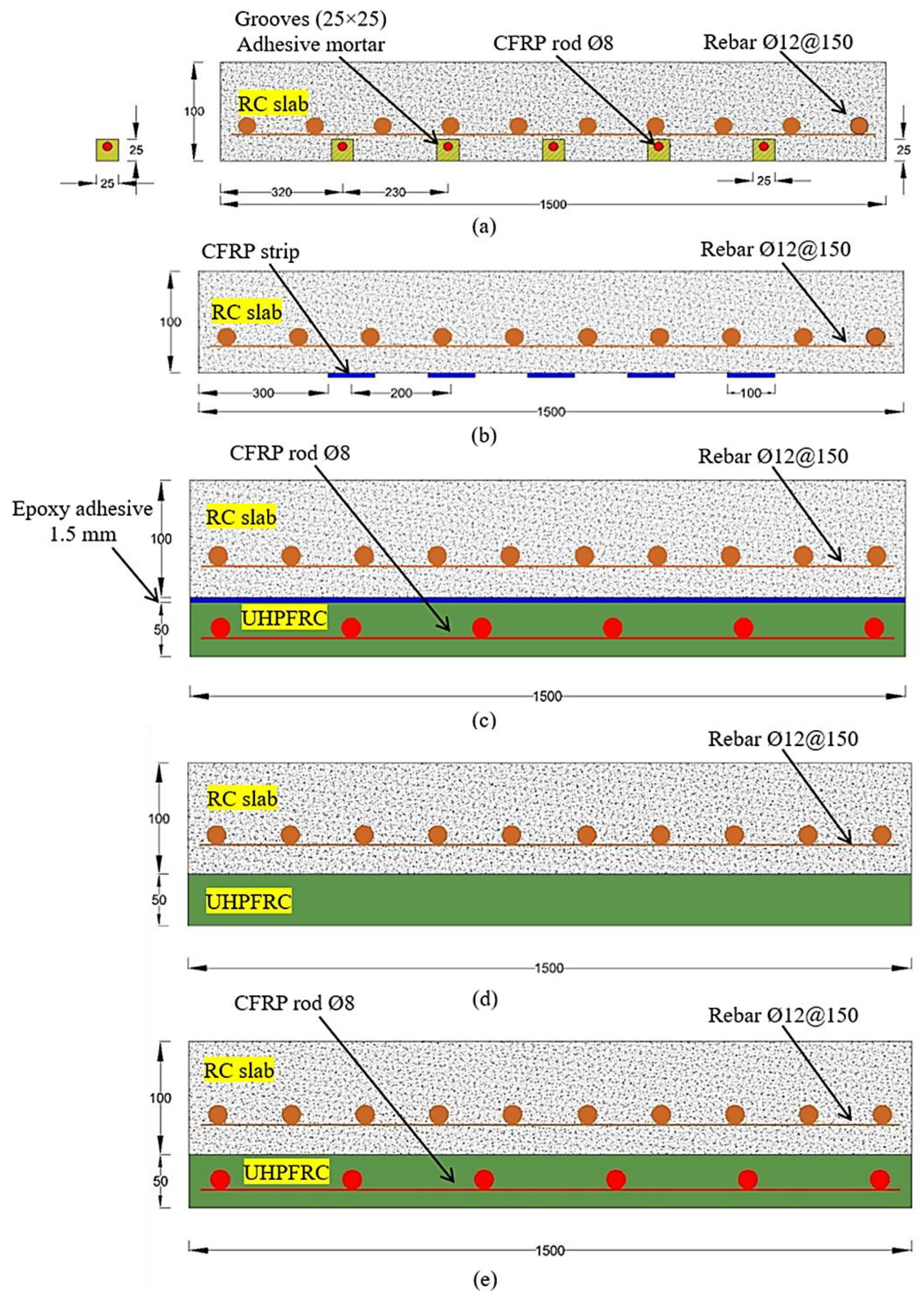
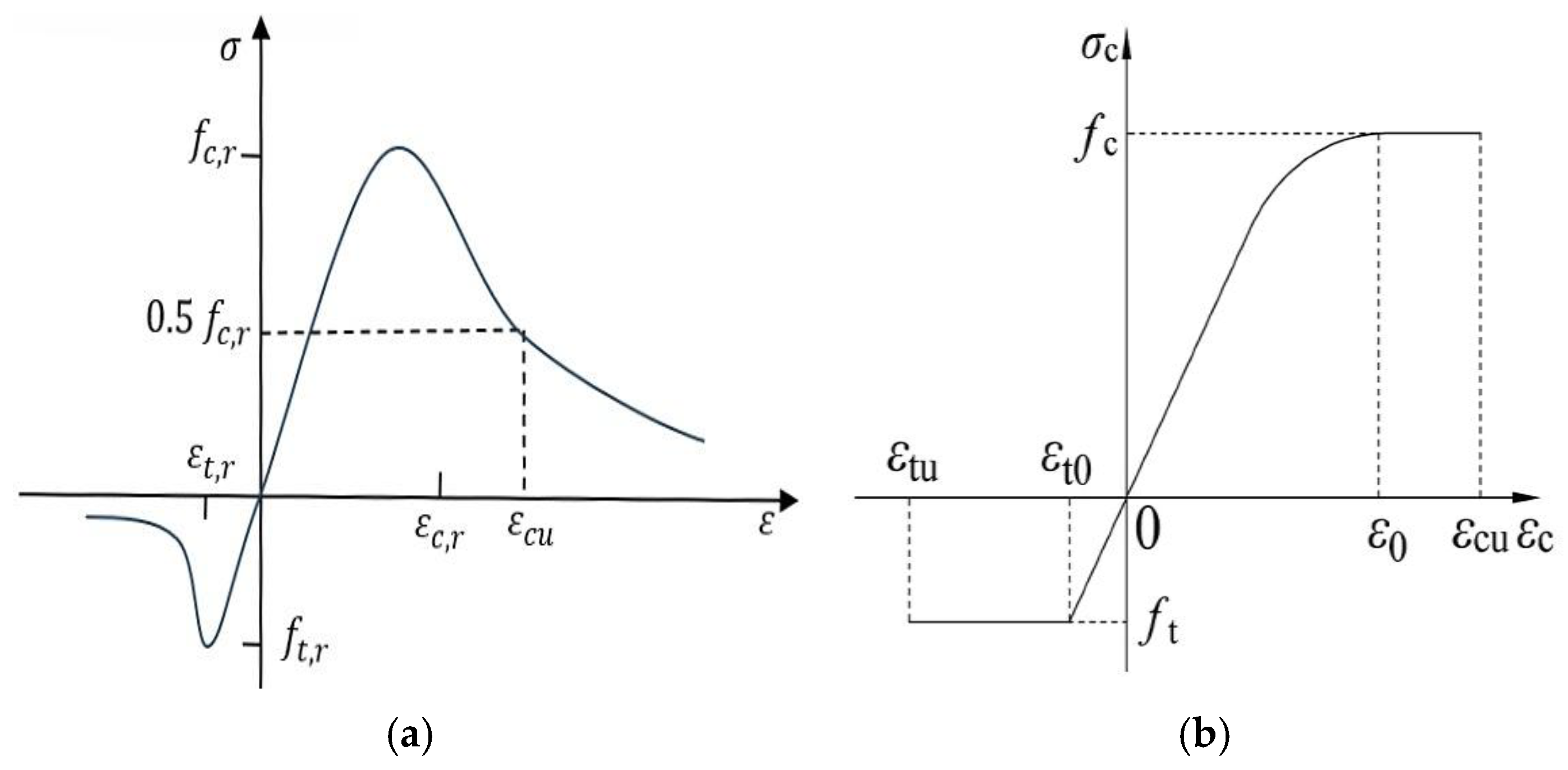


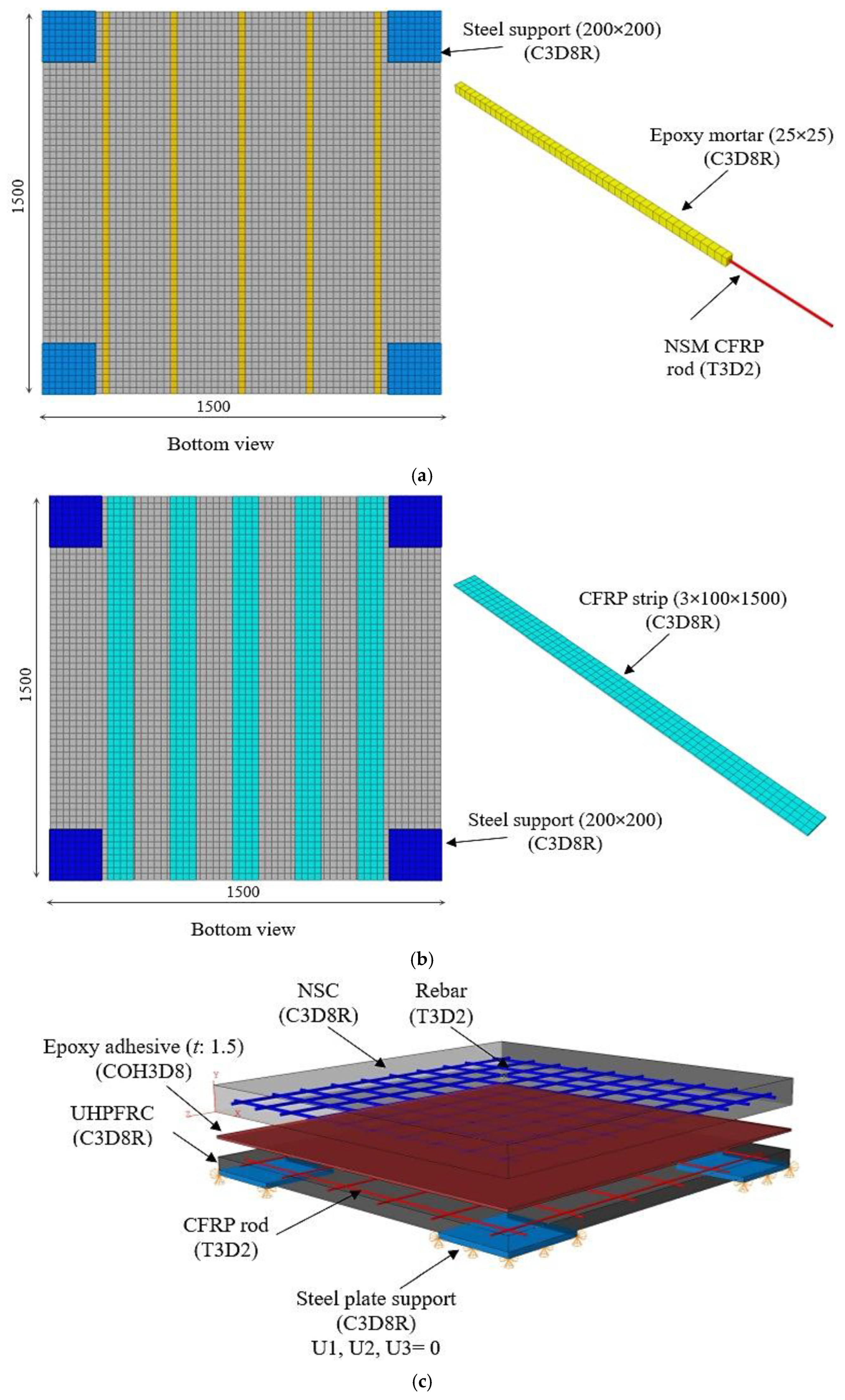
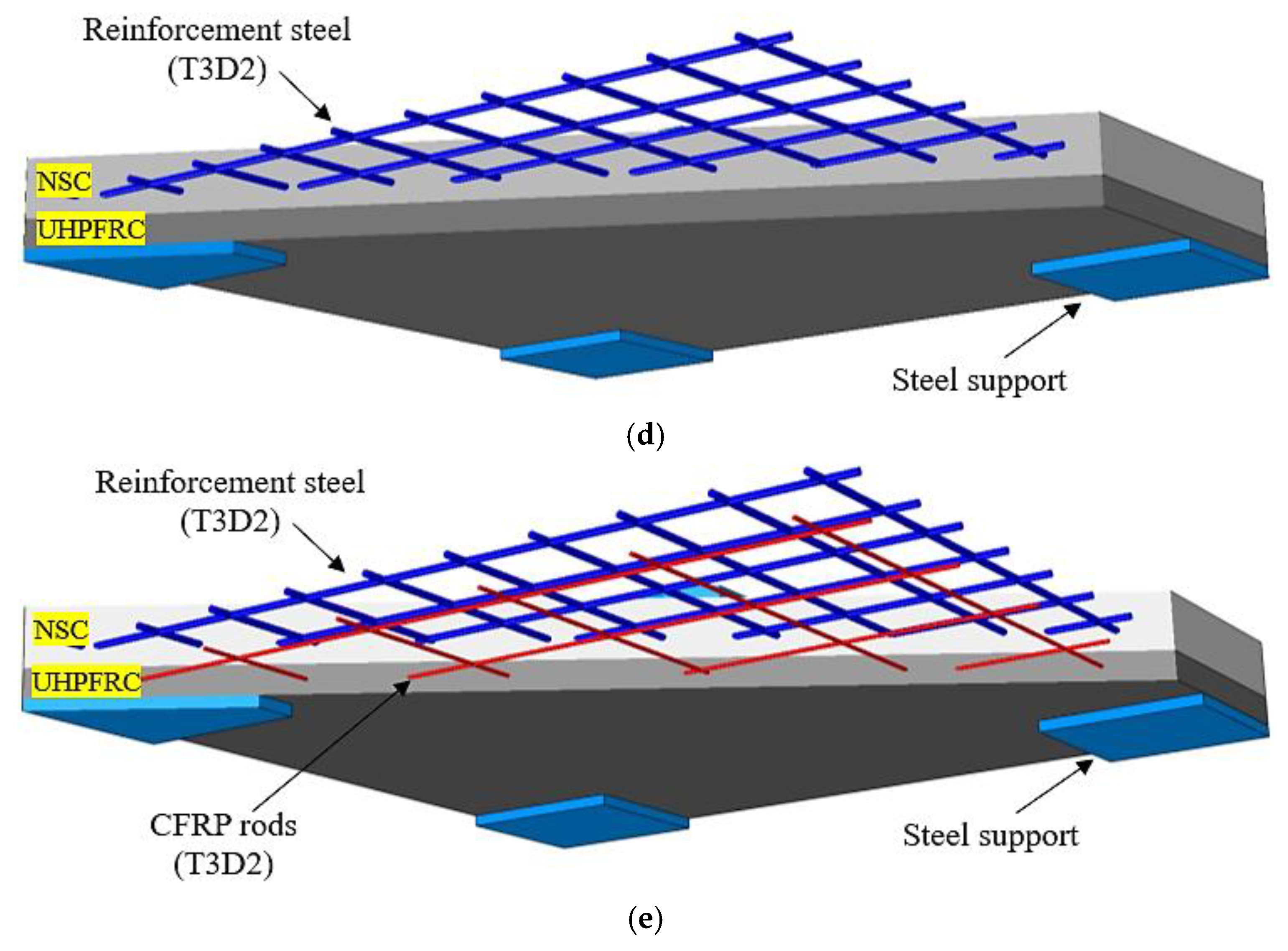
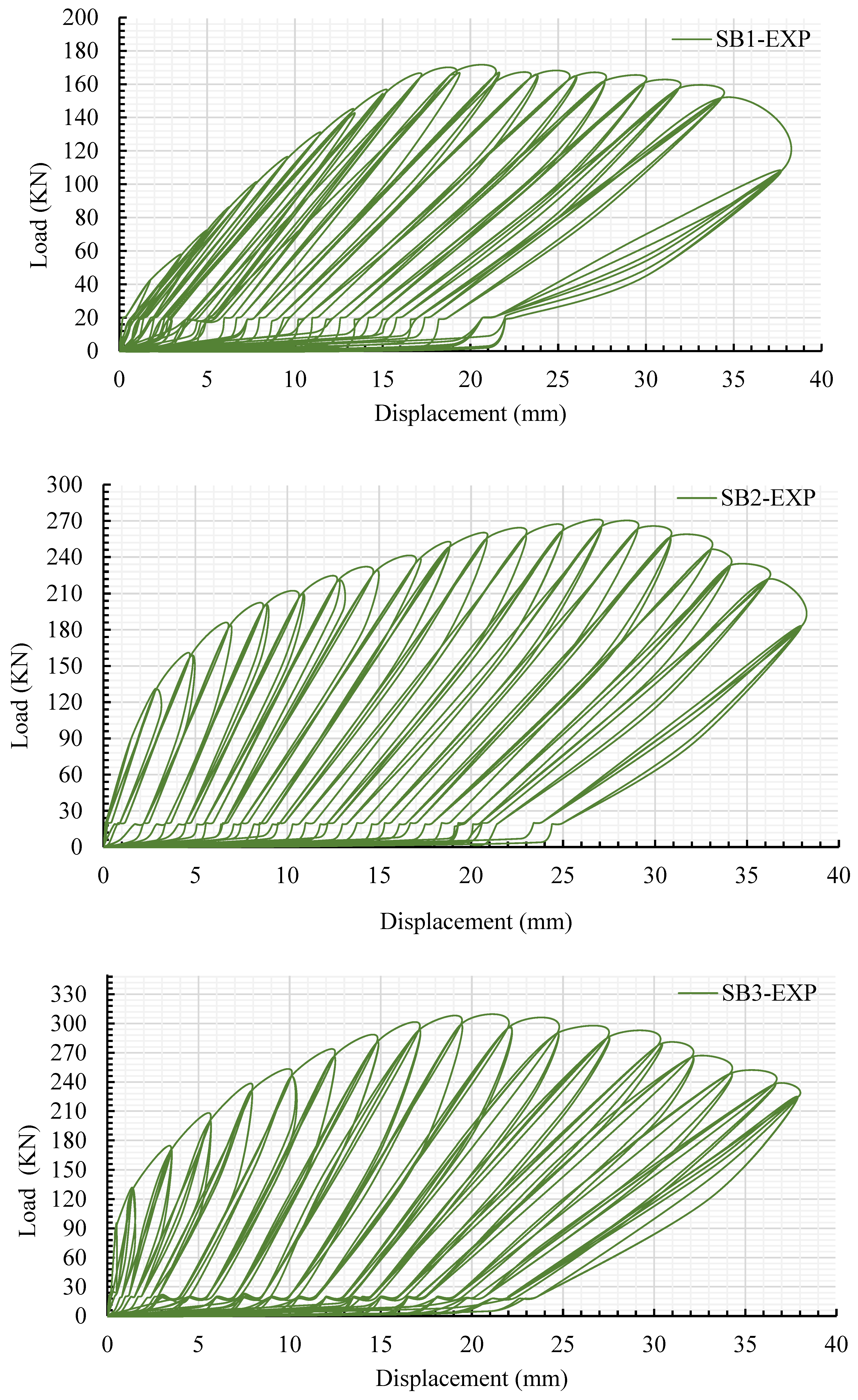
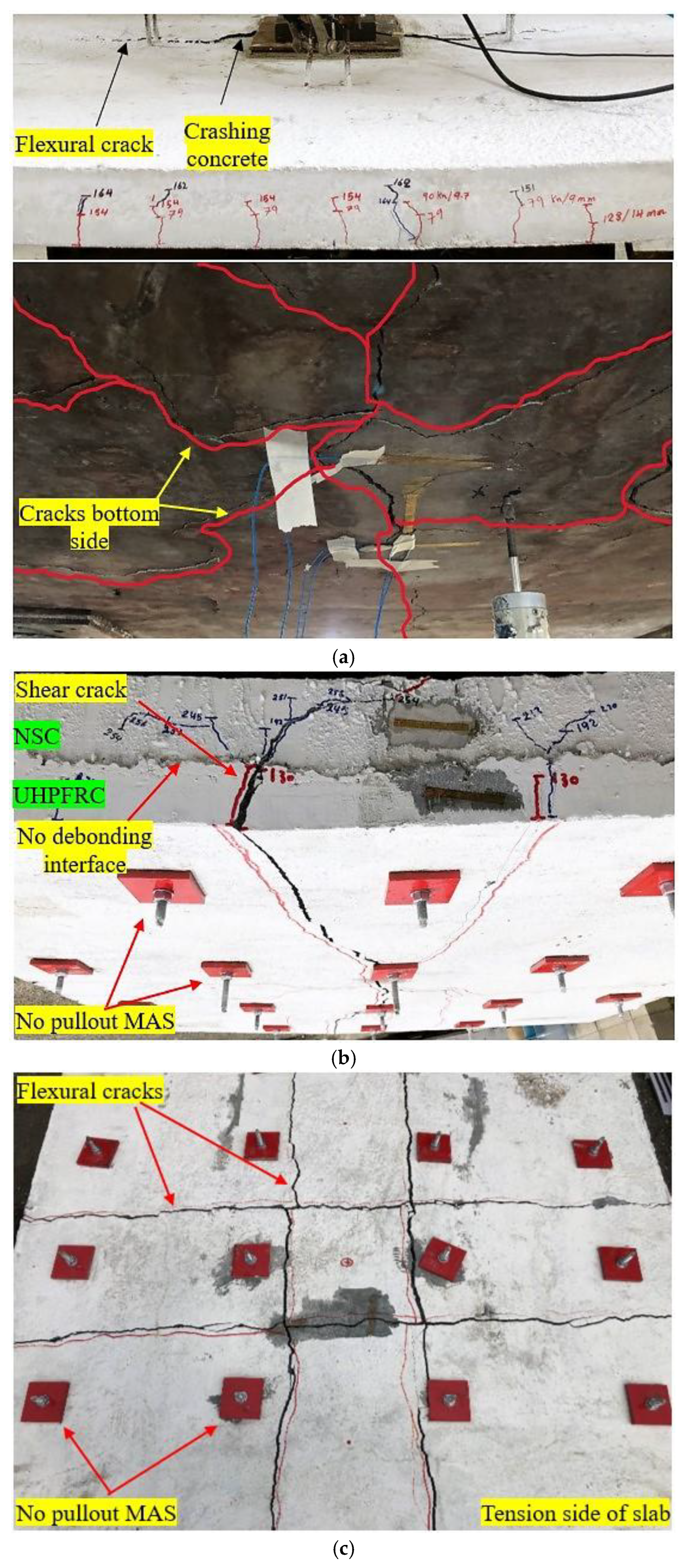


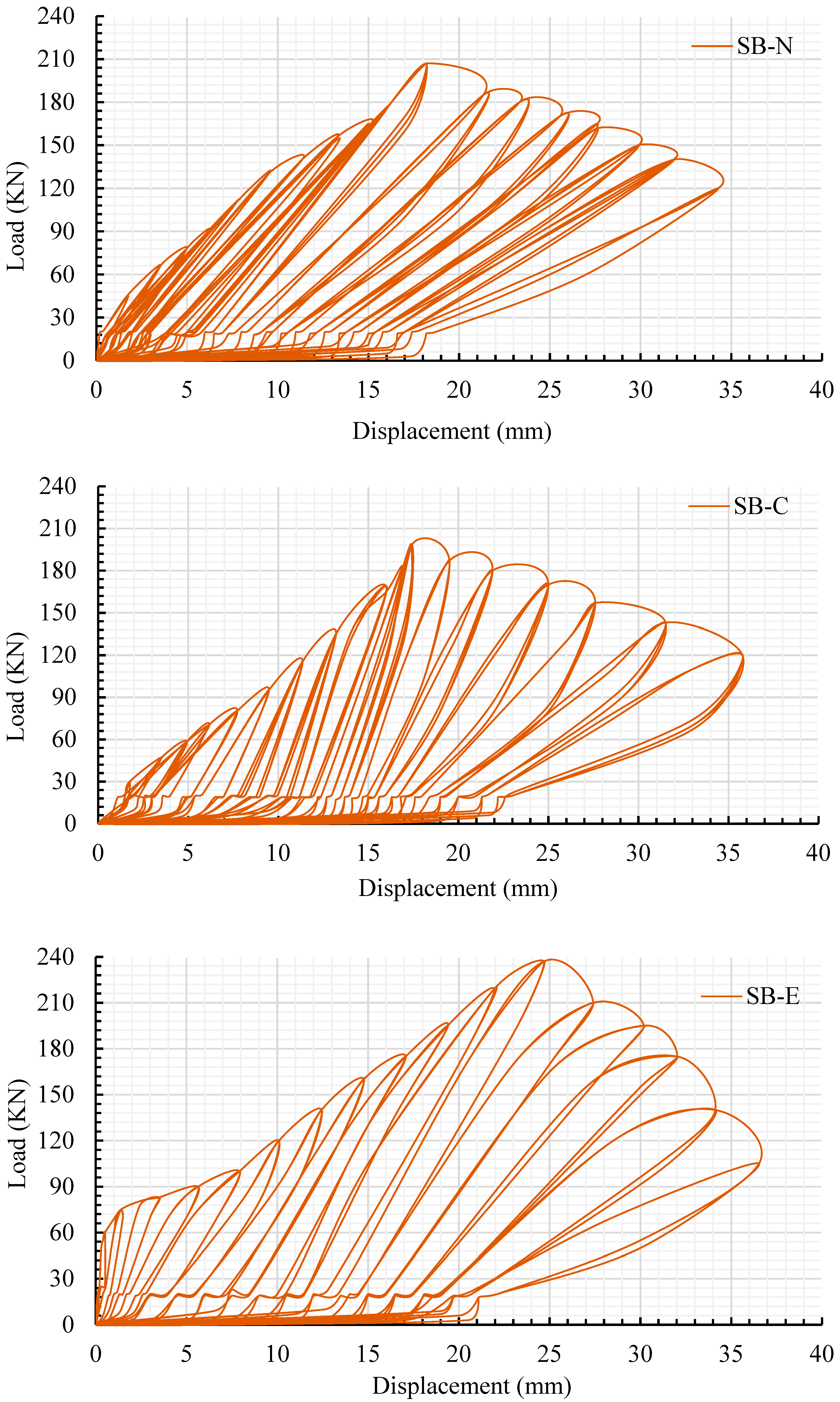

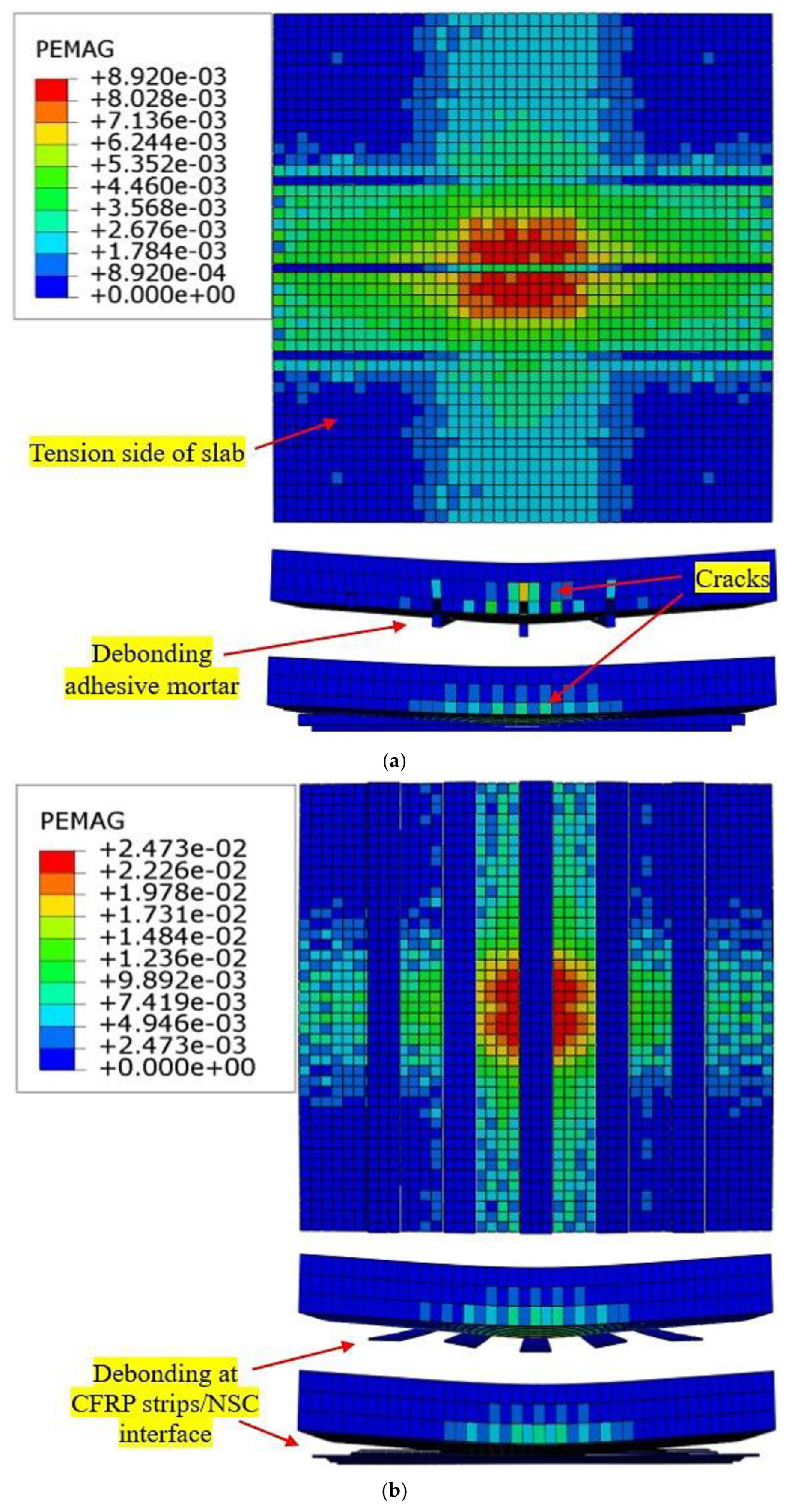
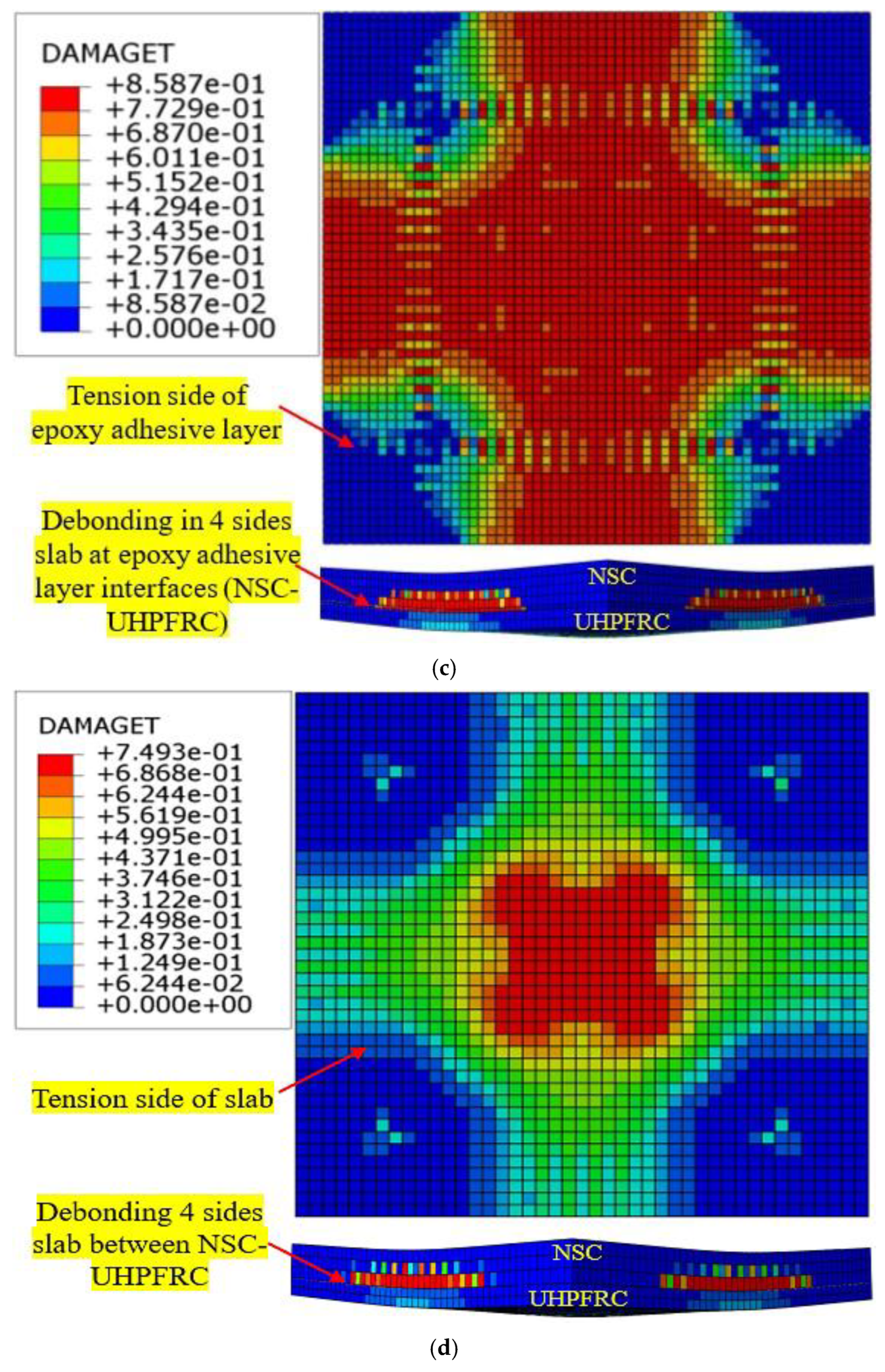
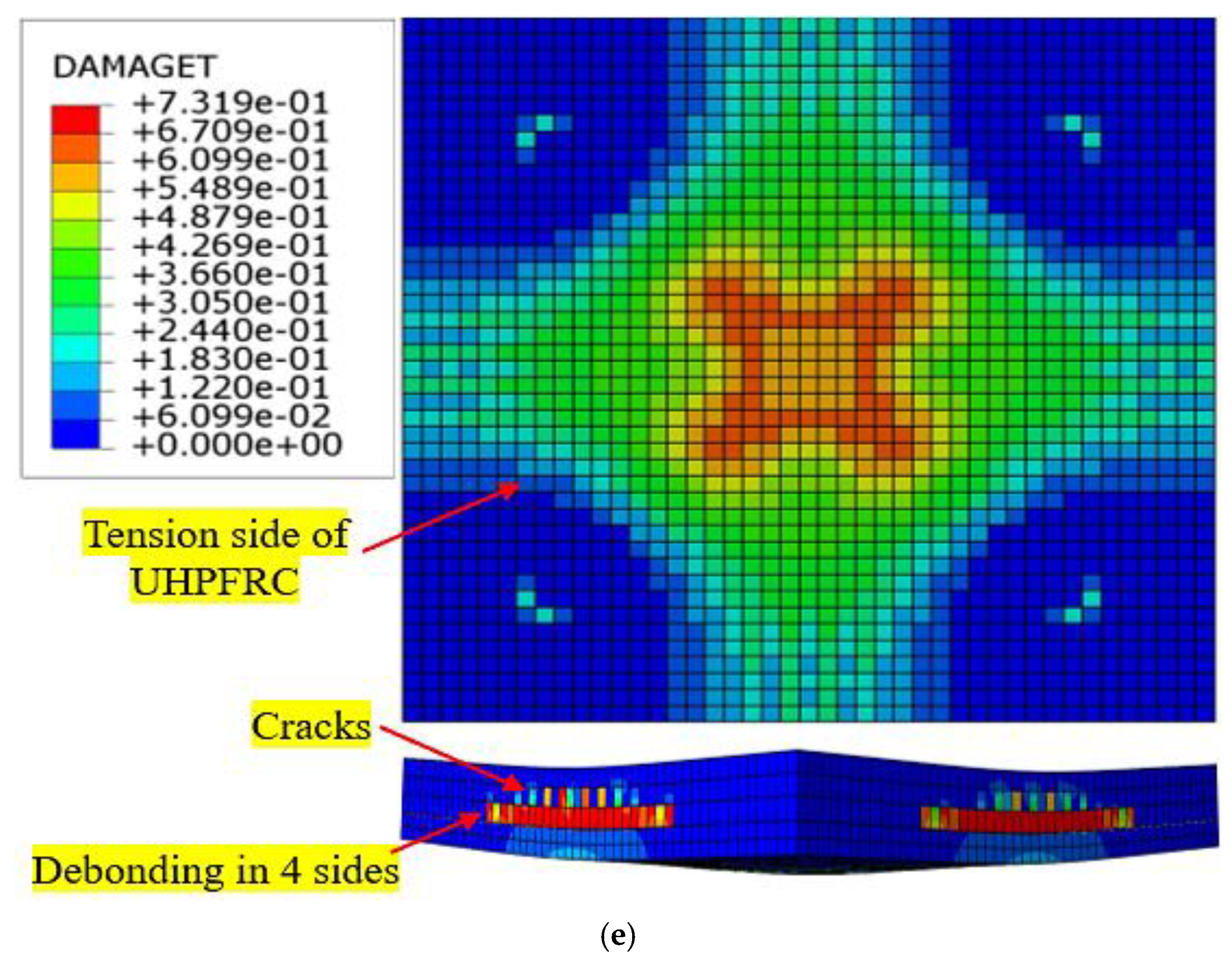
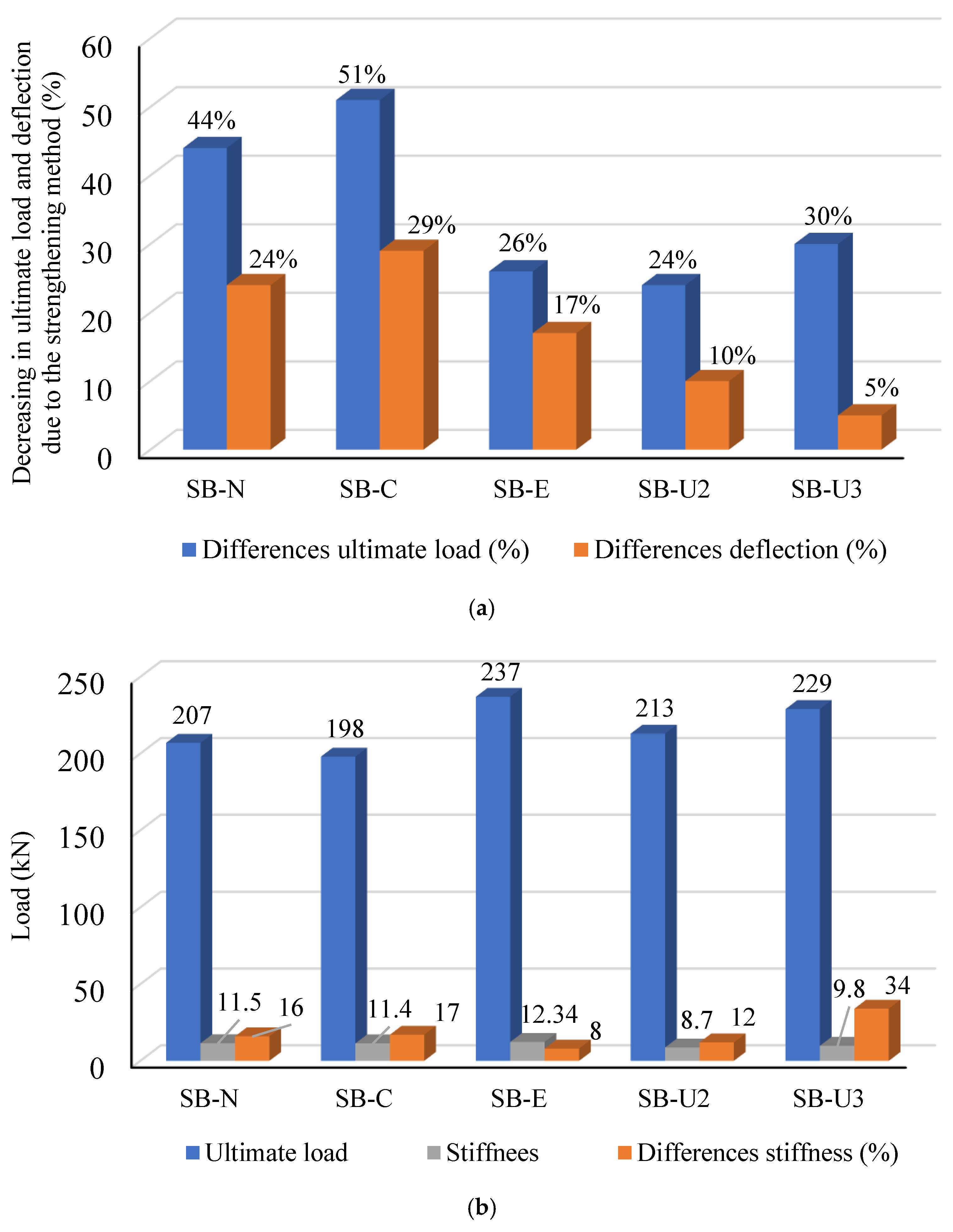


| Item | Quantity (kg/m3) |
|---|---|
| Dura UHPC premix | 560 |
| Admixture for reduction of water | 6.833 |
| Steel fiber (0.2 mm diameter, 20 mm length) | 42.1 ((2%) by vol.) |
| Water | 48 |
| Study | Specimen | Dimension | UHPFRC Thickness (mm) | Bonding Technique |
|---|---|---|---|---|
| Exp. | SB1 | 100 × 1500 × 1500 | - | Control slab |
| SB2 | 150 × 1500 × 1500 | 50 | Mechanical anchor system | |
| SB3 | 150 × 1500 × 1500 | 50 | Mechanical anchor system | |
| FE | SB1-F | 100 × 1500 × 1500 | - | Same as the experimental slab |
| SB2-F | 150 × 1500 × 1500 | 50 | Same as the experimental slab | |
| SB3-F | 150 × 1500 × 1500 | 50 | Same as the experimental slab | |
| SB-N | 100 × 1500 × 1500 | - | NSM | |
| SB-C | 100 × 1500 × 1500 | - | CFRP strip | |
| SB-E | 150 × 1500 × 1500 | 50 | Epoxy adhesive | |
| SB-U2 | 150 × 1500 × 1500 | 50 | Without mechanical anchor system | |
| SB-U3 | 150 × 1500 × 1500 | 50 | Without mechanical anchor system |
| Element Model | Characterization | Values |
|---|---|---|
| NSC | Compressive strength (MPa) | 34 |
| Elasticity modulus (GPa) | 27.4 | |
| Tensile strength (MPa) | 3.6 | |
| Poisson’s ratio | 0.2 | |
| Density (kg/m3) | 2200 | |
| UHPFRC | Compressive strength (MPa) | 144 |
| Elasticity modulus (GPa) | 56.4 | |
| Tensile strength (MPa) | 7.44 | |
| Poisson’s ratio | 0.2 | |
| Density (kg/m3) | 2300 |
| Properties | Rough |
|---|---|
| K n (N/mm3) | 1358 |
| K s and K t (N/mm3) | 20.358 |
| t n, t s and t t (MPa) | 5.63 |
| Total plastic displacement (mm) | 0.241 |
| Stabilization | 0.001 |
| Friction coefficient | 1.44 |
| Slab ID | Pc (kN) | Py (kN) | Pu (kN) | Δc (mm) | Δy (mm) | Δu (mm) | Increase Pu (%) | μΔu (%) | Stiffness (kN/mm) | E (kN.mm) | Failure Modes |
|---|---|---|---|---|---|---|---|---|---|---|---|
| SB1 | 79 | 152 | 164 | 6.14 | 16 | 18 | - | 1.1 | 9.1 | 4316 | F&C |
| SB2 | 130 | 221 | 264 | 4.1 | 15 | 27 | 61 | 1.8 | 9.7 | 7993 | S |
| SB3 | 156 | 244 | 298 | 3.4 | 11 | 22.4 | 82 | 2.03 | 13.3 | 8428 | F |
| Slab ID | Maximum Load {Pu (kN)} | Deflection at Maximum Load {Δu (mm)} | ||||
|---|---|---|---|---|---|---|
| Exp. | FE | Exp./FE | Exp. | FE | Exp./FE | |
| SB1 | 164 | 169 | 0.97 | 18 | 19.5 | 0.92 |
| SB2 | 264 | 260 | 1.01 | 27 | 26 | 1.04 |
| SB3 | 298 | 312 | 0.96 | 22.4 | 22 | 1.02 |
| SB-N | - | 207 | 1.44 * | - | 18 | 1.24 * |
| SB-C | - | 198 | 1.5 * | - | 17.4 | 1.29 * |
| SB-E | - | 237 | 1.26 * | - | 19.2 | 1.17 * |
| SB-U2 | - | 213 | 1.24 ** | - | 24.6 | 1.09 ** |
| SB-U3 | - | 229 | 1.31 * | - | 23.5 | 0.95 * |
| COV1 (%) | 3.4 | 5.29 | ||||
| COV2 (%) | 21 | 9.73 | ||||
| COV3 (%) | 22 | 11.7 | ||||
| COV4 (%) | 14 | 6.85 | ||||
| COV5 (%) | 11.4 | 2.85 | ||||
| COV6 (%) | 15.8 | 3.95 | ||||
| ID | Mu (Exp.) (KN.m) | Mu (FE) (KN.m) | Mu (An) (KN.m) | Exp./An * | FE/An |
|---|---|---|---|---|---|
| SB1 | 53 | 55 | 51 | 1. 04 | 1.07 |
| SB2 | 86 | 84 | 90 | 0.95 | 1.03 |
| SB3 | 97 | 101 | 102 | 0.95 | 1.003 |
| SB-N | - | 67 | 73 | - | 0.92 |
| SB-C | - | 64 | 59 | - | 1.08 |
| SB-E | - | 77 | 82 | - | 0.94 |
| [56] BS2 | 52 | 55 | 59 | 0.88 | 0.93 |
| BS3 | 69 | 70 | 77 | 0.9 | 0.91 |
| [26] ST_UHPFR_CS | 41 | 39 | 45 | 0.91 | 0.86 |
| ST_UHPFR_TS | 42 | 63 | 47 | 0.89 | 1.34 |
| COV (%) | 4.3 | 6 |
Disclaimer/Publisher’s Note: The statements, opinions and data contained in all publications are solely those of the individual author(s) and contributor(s) and not of MDPI and/or the editor(s). MDPI and/or the editor(s) disclaim responsibility for any injury to people or property resulting from any ideas, methods, instructions or products referred to in the content. |
© 2025 by the authors. Licensee MDPI, Basel, Switzerland. This article is an open access article distributed under the terms and conditions of the Creative Commons Attribution (CC BY) license (https://creativecommons.org/licenses/by/4.0/).
Share and Cite
Saeed, F.H.; Hejazi, F. Application of Carbon-Fiber-Reinforced Polymer Rods and Ultra-High-Performance Fiber-Reinforced Concrete Jackets with Mechanical Anchorage Systems to Reinforced Concrete Slabs. Fibers 2025, 13, 33. https://doi.org/10.3390/fib13030033
Saeed FH, Hejazi F. Application of Carbon-Fiber-Reinforced Polymer Rods and Ultra-High-Performance Fiber-Reinforced Concrete Jackets with Mechanical Anchorage Systems to Reinforced Concrete Slabs. Fibers. 2025; 13(3):33. https://doi.org/10.3390/fib13030033
Chicago/Turabian StyleSaeed, Firas Hassan, and Farzad Hejazi. 2025. "Application of Carbon-Fiber-Reinforced Polymer Rods and Ultra-High-Performance Fiber-Reinforced Concrete Jackets with Mechanical Anchorage Systems to Reinforced Concrete Slabs" Fibers 13, no. 3: 33. https://doi.org/10.3390/fib13030033
APA StyleSaeed, F. H., & Hejazi, F. (2025). Application of Carbon-Fiber-Reinforced Polymer Rods and Ultra-High-Performance Fiber-Reinforced Concrete Jackets with Mechanical Anchorage Systems to Reinforced Concrete Slabs. Fibers, 13(3), 33. https://doi.org/10.3390/fib13030033







